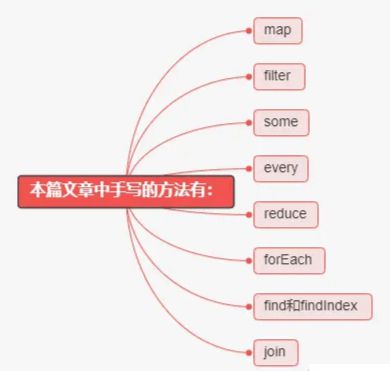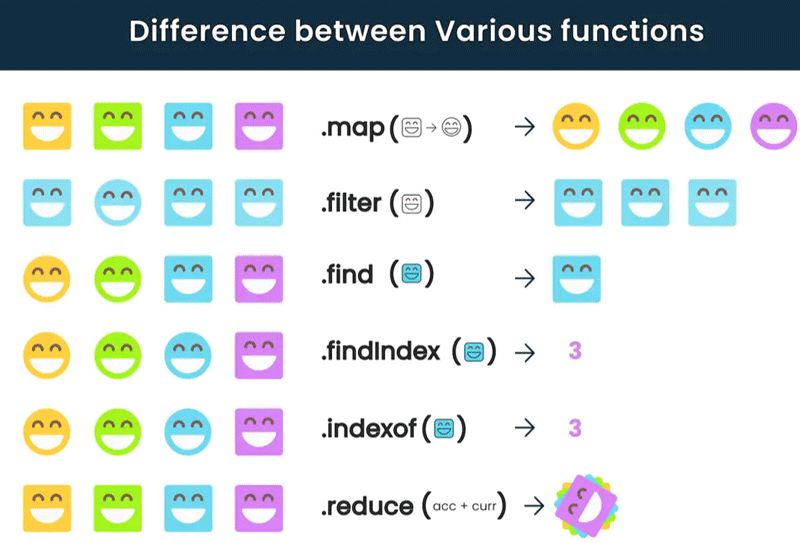归纳整理JavaScript数组实例的9个方法
3174
本篇文章给大家带来了关于javascript的相关知识,主要介绍了JavaScript数组实例的9个方法,文章围绕主题展开详细的内容介绍没具有一定的参考价值,需要的朋友可以参考一下。

前言
手写JS原生API在面试中很常见,今天努力工作之余(摸鱼的时候)翻到了MDN文章中关于数组实例方法这部分,正好无聊就手写几个实例方法玩玩,复习一下基础内容,并记录一下。

如果你还不知道数组实例中迭代方法有什么区别,可以看下面这张图:

map
这个方法会返回一个新的数组,数组中的每一项都是执行过map提供的回调函数结果。
实现代码如下:
const map = (array, fun) => {
// 类型约束
if (Object.prototype.toString.call(array) !== '[object Array]')
throw new TypeError(array + ' is not a array')
if (typeof fun !== 'function') throw new TypeError(fun + ' is not a function')
// 定义一个空数组,用于存放修改后的数据
let res = []
for (let i = 0; i < array.length; i++) {
res.push(fun(array[i]))
}
return res
}
// 测试
let res = map([1, 2, 3], item => {
return item * 2
})
console.log(res) // [ 2, 4, 6 ]filter
这个方法会返回一个新的数组,数组中的值是满足filter提供的回调函数的值,
实现代码如下:
const filter = (array, fun) => {
// 类型约束
if (Object.prototype.toString.call(array) !== '[object Array]')
throw new TypeError(array + ' is not a array')
if (typeof fun !== 'function') throw new TypeError(fun + ' is not a function')
// 定义一个空数组,用于存放符合条件的数组项
let res = []
for (let i = 0; i < array.length; i++) {
// 将数组中的每一项都调用传入的函数,如果返回结果为true,则将结果push进数组,最后返回
fun(array[i]) && res.push(array[i])
}
return res
}
// 测试
let res = filter([1, 2, 3], item => {
return item > 2
})
console.log(res) // [ 3 ]some
该方法会判断数组中的每一项,如果有一项满足回调函数中条件就返回true都不满足则返回false。
实现代码如下:
const some = (array, fun) => {
// 类型约束
if (Object.prototype.toString.call(array) !== '[object Array]')
throw new TypeError(array + ' is not a array')
if (typeof fun !== 'function') throw new TypeError(fun + ' is not a function')
let flag = false
for (let i of array) {
if (fun(i)) {
flag = true
break
}
}
return flag
}
let res = some([1, 2, 3], item => {
return item > 2
})
console.log(res) // trueevery
该方法会判断数组中的每一项,如果所有项满足回调函数中条件就返回true否则返回false。
实现代码如下:
const every = (array, fun) => {
// 类型约束
if (Object.prototype.toString.call(array) !== '[object Array]')
throw new TypeError(array + ' is not a array')
if (typeof fun !== 'function') throw new TypeError(fun + ' is not a function')
let flag = true
for (let i of array) {
if (!fun(i)) {
flag = false
break
}
}
return flag
}
let res = every([1, 2, 3], item => {
return item > 0
})
console.log(res) // truereduce
该方法会让数组中的每个元素执行我们提供的回调函数,并将结果汇总返回
实现代码如下:
const reduce = (array, fun, initialValue) => {
// 类型约束
if (Object.prototype.toString.call(array) !== '[object Array]')
throw new TypeError(array + ' is not a array')
if (typeof fun !== 'function') throw new TypeError(fun + ' is not a function')
let accumulator = initialValue
for (let i = 0; i < array.length; i++) {
accumulator = fun(accumulator, array[i], i, array)
}
return accumulator
}
const arr = [1, 2, 3]
console.log(arr.reduce(v => v + 10, 10)) // 40
console.log(reduce(arr, v => v + 10, 10)) // 40forEach
这个方法比较简答了,就是遍历数组方法,数组中的每一项都执行回调函数
实现代码如下:
const forEach = (array, fun) => {
// 类型约束
if (Object.prototype.toString.call(array) !== '[object Array]')
throw new TypeError(array + ' is not a array')
if (typeof fun !== 'function') throw new TypeError(fun + ' is not a function')
for (let i of array) {
fun(i)
}
}
let res = forEach([1, 2, 3], item => {
console.log(item)
})forEach
这个方法比较简答了,就是遍历数组方法,数组中的每一项都执行回调函数
实现代码如下:
const forEach = (array, fun) => {
// 类型约束
if (Object.prototype.toString.call(array) !== '[object Array]')
throw new TypeError(array + ' is not a array')
if (typeof fun !== 'function') throw new TypeError(fun + ' is not a function')
for (let i of array) {
fun(i)
}
}
let res = forEach([1, 2, 3], item => {
console.log(item)
})find和findIndex
这两个方法比较类似,一个返回元素,一个返回元素的索引,这里就编写一个
实现代码如下:
const myFind = (array, fun) => {
// 类型约束
if (Object.prototype.toString.call(array) !== '[object Array]')
throw new TypeError(array + ' is not a array')
if (typeof fun !== 'function') throw new TypeError(fun + ' is not a function')
let res
for (let i = 0; i < array.length; i++) {
if (fun(array[i])) {
res = array[i]
}
}
return res
}
// 测试
let res = myFind([1, 2, 3], item => {
return item > 2
})
console.log(res) // 3join
该方法可以将数组中的所有元素根据指定的字符串进行拼接,并返回拼接后的字符串,
实现代码如下:
const join = (array, separator = ',') => {
// 类型约束
if (Object.prototype.toString.call(array) !== '[object Array]')
throw new TypeError(array + ' is not a array')
if (typeof separator !== 'string')
throw new TypeError(separator + ' is not a string')
let res = array[0].toString()
for (let i = 0; i < array.length - 1; i++) {
res += separator + array[i + 1].toString()
}
return res
}
// 测试
let res = join([1, 2, 3], '-')
console.log(res) // 1-2-3本文网址:https://www.zztuku.com/detail-13008.html
站长图库 - 归纳整理JavaScript数组实例的9个方法
申明:本文转载于《脚本之家》,如有侵犯,请 联系我们 删除。








您还没有登录,请 登录 后发表评论!
提示:请勿发布广告垃圾评论,否则封号处理!!